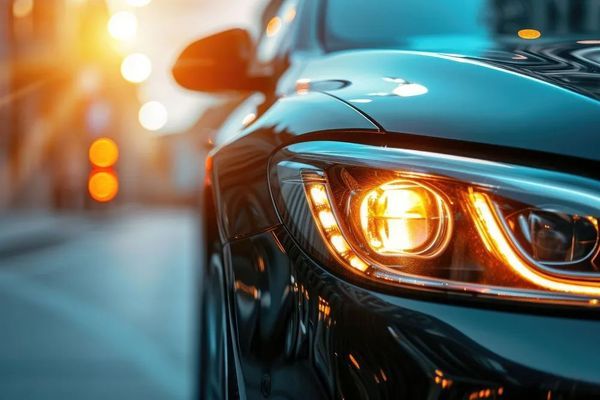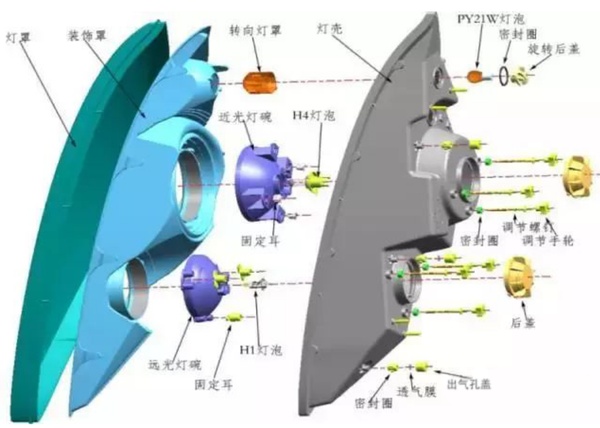Revolution in Headlight Cover Materials: Understanding the Logic Behind Material Selection from Wanhua Chemical's Breakthrough
In March 2025, a certification announcement from the South Korean Hyundai Kia Group caused a stir in the global automotive industry chain — WanHua Chemical's Clarnate® HL6157 optical-grade polycarbonate (PC) material officially passed the headlight cover certification, becoming the first Chinese chemical company to enter the group's core supplier system. This is not only a landmark event for the internationalization of China's new materials industry but also reflects that the technological competition in the headlight cover material field has entered a deep water zone.

In the context of new energy vehicles penetration rate breaking 40% and the popularization of intelligent driving functions, car lights have long surpassed basic illumination functions to become a core expression of vehicle design language and a key carrier of safety systems. As a core component of the automotive lighting system, the material for car light covers needs to meet multiple stringent standards, including high light transmittance, weather resistance, and impact resistance.
We have noticed that the material chosen by Wanhua Chemical is a PC material. Why would the front headlight cover choose PC material? What are the common materials for vehicle lights? What preferences do car manufacturers have when choosing vehicle light materials?
Car lights usually use these materials
The data shows that it is composed of mirrors, lenses, housing/light source, electronic circuits, and installation accessories. The main plastic raw materials used in car lights in the country include PC, PP, ABS, PMMA, and a few other plastic materials. In terms of the materials for various components of the car lights, different plastics are used, for example, the cover of the car's front headlights generally selects PC instead of PMMA.
1.PCpolycarbonate
PC has a wide range of applications in vehicle lighting. According to relevant data, PC series materials account for about 50% (by weight) of the plastic materials used in headlights. In vehicle lighting, PC is mainly used in the lenses and outer light distribution mirrors of headlights and fog lights. PC, also known as polycarbonate, has excellent impact resistance and transparency, good mechanical properties and electrical insulation, a wide range of operating temperatures, high dimensional stability, and high resistance to creep. The internal structure of the vehicle lights results in certain temperature differences in different parts, with some reflectors and decorative rings possibly reaching temperatures of 100-90°C. When selecting materials, PC and PC-HT are generally chosen.

front headlight structure
2.PP(polypropylene)
The PP used in car lights is mostly modified PP, accounting for about 3% of the weight of plastic materials in car lights. For example, the rear cover, decorative panel, and wire harness guide slot (PP-T20) of the taillight, as well as the housing and rear cover of the headlight, generally use PP. Currently, PP is the main material for headlight housings. PP has strong electrical insulation and chemical resistance, good fatigue resistance, and among general plastics, it has the highest mechanical properties and heat resistance. In addition, compared to other plastics, it also has a price advantage.
3.PBT/PET
PBT (polybutylene terephthalate) is mainly used in the manufacture of automotive lamps for components such as headlight bezels and adjustment device brackets. By modifying it with ASA and adding glass fiber reinforcement, its overall performance is significantly improved, making it suitable for fog lamp housing production. PBT has mechanical properties similar to PA and POM, while also featuring a low coefficient of friction, self-lubrication, and excellent thermal and chemical stability, especially in terms of hydrolysis resistance. It exhibits excellent melt flowability, with a molding shrinkage rate as low as 0.3%-0.6%, high dimensional accuracy, and processing efficiency that is significantly better than traditional materials. Compared to heat-resistant PC, the PBT system's heat resistance temperature is increased by 20-30°C, capable of withstanding local temperatures up to 190°C in headlights, and the material cost is reduced by about 40%, making it a core choice for current lightweight and cost-reduction strategies in automotive lighting.
In recent years, the material for car light decorative rings has gradually shifted from heat-resistant PC to PBT/PET systems. This transition is not only due to the higher heat resistance and processing performance of PBT/PET (melt index reaching 35-45g/10min), but also because it can achieve a reflectivity of over 92% through vacuum deposition technology, meeting the dual needs of optical performance and surface aesthetics for car lights.
4.PA(nylon)
The PA used in car lights is generally PA+GF, and ordinary screws or brackets in car lights use PA6+GF or PA66+GF. Aromatic PA has a higher heat resistance temperature and strength than ordinary PA, and some important adjustment structures and internal brackets in car lights also use aromatic PA with glass fiber.
5.PMMA
PMMA, commonly known as acrylic or organic glass, is a highly transparent amorphous thermoplastic material. It has excellent optical properties, with a light transmittance of 90%-92%, a refractive index of 1.49, good weather resistance, high surface hardness, and excellent overall performance. It is mainly used for optically clear products, such as the outer lenses of taillights and light guide materials for interior ambient lighting.
6.ABS、PC/ABS
In the field of vehicle lighting, ABS is generally used after being modified with PC material, and the proportion of PC content in ABS is determined by the usage temperature and impact performance. ABS and PC/ABS are typically used for tail light housings and trim panels.
7.BMC、PEI、PEEK、PPS、LCPand materials
Headlight reflectors mainly use materials such as BMC and PET. BMC is a new type of material that combines the advantages of thermosetting plastics and reinforced engineering plastics. During injection molding, it can flow uniformly at the same time, and can be molded in one go within an extremely short period, featuring high rigidity and strength, as well as good molding shrinkage and dimensional accuracy stability.
Based on the aforementioned characteristics of BMC, the reflectors of front headlights generally use BMC. The primary function of front headlights is to illuminate the road ahead, ensuring the vehicle can travel normally. The reflector, in conjunction with the corresponding bulb, can emit two types of light patterns: low beam and high beam. Additionally, the low beam must have a clear demarcation line between light and dark areas and high illumination, so the good molding shrinkage and dimensional accuracy stability of BMC can meet this requirement. Rear taillights typically use materials such as PET and PC, or are directly molded from the lamp hub. Rear taillights combine signal light functions, and their dimensional accuracy requirements are not as high as those for front headlights. However, if the reflector can be seen directly through the lamp cover, the reflective surface of the reflector must be designed to be aesthetically pleasing to ensure that it produces a unique light pattern when lit.
Factors to Consider in the Selection of Plastic Materials for Car Lights
Returning to the initial question: Why is PC chosen for car headlight covers instead of PMMA?
PC and PMMA both have high transparency and good processing characteristics, but there are some differences in their application to vehicle lights. First, in terms of heat resistance, PC can generally reach 130℃, while PMMA is only around 100℃. Second, PC material has better toughness, whereas PMMA material is very brittle and easily breaks upon impact. Finally, the unit price of PC is higher than that of PMMA, and its fluidity during molding is not as good as PMMA. Generally, the covers of front headlights are made of PC, mainly because the front headlights have high luminosity, emit a lot of heat, and are located at the front of the vehicle, which requires a material that is both heat-resistant and impact-resistant.
The rear light covers are generally made of PMMA. Apart from the cost factor, rear lights are usually a combination of single-function signal lights, requiring an alternating pattern of red and transparent colors. Therefore, PMMA with good fluidity is the ideal choice.
Therefore, when selecting vehicle lights, they first need to meet performance requirements, and in addition, material costs and compliance are also very important.
Trend of material selection for vehicle lights
Currently, the application trend of automotive lighting plastics is towards high performance, lightweight, and environmentally friendly energy-saving directions. As the automotive industry continues to advance, the performance requirements for automotive lighting plastics are also increasing, requiring better heat resistance, light transmittance, impact resistance, UV resistance, and higher heat dissipation performance.
At the same time, to reduce the overall weight of the vehicle and lower fuel consumption, lightweighting is also an important development trend. In addition, the requirements for environmental protection and energy saving have also prompted the automotive lighting plastics industry to continuously introduce new materials and processes that meet environmental standards.
Editor: Lily
【Copyright and Disclaimer】This article is the property of PlastMatch. For business cooperation, media interviews, article reprints, or suggestions, please call the PlastMatch customer service hotline at +86-18030158354 or via email at service@zhuansushijie.com. The information and data provided by PlastMatch are for reference only and do not constitute direct advice for client decision-making. Any decisions made by clients based on such information and data, and all resulting direct or indirect losses and legal consequences, shall be borne by the clients themselves and are unrelated to PlastMatch. Unauthorized reprinting is strictly prohibited.
Most Popular
-

List Released! Mexico Announces 50% Tariff On 1,371 China Product Categories
-

Nissan Cuts Production of New Leaf EV in Half Due to Battery Shortage
-

New Breakthrough in Domestic Adiponitrile! Observing the Rise of China's Nylon Industry Chain from Tianchen Qixiang's Production
-

Dow, Wanhua, Huntsman Intensively Raise Prices! Who Controls the Global MDI Prices?
-

Mexico officially imposes tariffs on 1,400 chinese products, with rates up to 50%






